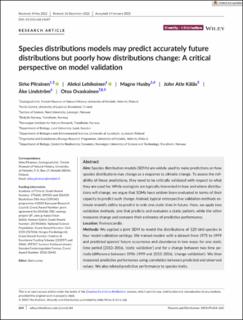| dc.contributor.author | Piirainen, Sirke | |
| dc.contributor.author | Lehikoinen, Aleksi | |
| dc.contributor.author | Husby, Magne | |
| dc.contributor.author | Kålås, John Atle | |
| dc.contributor.author | Lindström, Åke | |
| dc.contributor.author | Ovaskainen, Otso Tapio | |
| dc.date.accessioned | 2023-09-22T08:27:11Z | |
| dc.date.available | 2023-09-22T08:27:11Z | |
| dc.date.created | 2023-03-27T10:47:31Z | |
| dc.date.issued | 2023 | |
| dc.identifier.citation | Piirainen, S., Lehikoinen, A., Husby, M., Kålås, J. A., Lindström, Å., & Ovaskainen, O. (2023). Species distributions models may predict accurately future distributions but poorly how distributions change: A critical perspective on model validation. Diversity and Distributions: A journal of biological invasions and biodiversity, 29(5), 654-665. doi: | en_US |
| dc.identifier.issn | 1472-4642 | |
| dc.identifier.uri | https://hdl.handle.net/11250/3091273 | |
| dc.description.abstract | Aim: Species distribution models (SDMs) are widely used to make predictions on how species distributions may change as a response to climatic change. To assess the reli-ability of those predictions, they need to be critically validated with respect to what they are used for. While ecologists are typically interested in how and where distribu-tions will change, we argue that SDMs have seldom been evaluated in terms of their capacity to predict such change. Instead, typical retrospective validation methods es-timate model's ability to predict to only one static time in future. Here, we apply two validation methods, one that predicts and evaluates a static pattern, while the other measures change and compare their estimates of predictive performance. Location: Fennoscandia. Methods: We applied a joint SDM to model the distributions of 120 bird species in four model validation settings. We trained models with a dataset from 1975 to 1999 and predicted species' future occurrence and abundance in two ways: for one static time period (2013–2016, ‘static validation’) and for a change between two time pe-riods (difference between 1996–1999 and 2013–2016, ‘change validation’). We then measured predictive performance using correlation between predicted and observed values. We also related predictive performance to species traits. Results: Even though static validation method evaluated predictive performance as good, change method indicated very poor performance. Predictive performance was not strongly related to any trait.Main Conclusions: Static validation method might overestimate predictive perfor-mance by not revealing the model's inability to predict change events. If species' dis-tributions remain mostly stable, then even an unfit model can predict the near future well due to temporal autocorrelation. We urge caution when working with forecasts of changes in spatial patterns of species occupancy or abundance, even for SDMs that are based on time series datasets unless they are critically validated for forecasting such change. birds, climate change, Fennoscandia, forecasting, land use, model validation, prediction, species distribution modelling, species traits, temporal transferability | en_US |
| dc.language.iso | eng | en_US |
| dc.publisher | Wiley | en_US |
| dc.rights | Navngivelse 4.0 Internasjonal | * |
| dc.rights.uri | http://creativecommons.org/licenses/by/4.0/deed.no | * |
| dc.title | Species distributions models may predict accurately future distributions but poorly how distributions change : A critical perspective on model validation | en_US |
| dc.type | Peer reviewed | en_US |
| dc.type | Journal article | en_US |
| dc.description.version | publishedVersion | en_US |
| dc.rights.holder | © 2023 The Authors | en_US |
| dc.subject.nsi | VDP::Zoologiske og botaniske fag: 480 | en_US |
| dc.subject.nsi | VDP::Zoology and botany: 480 | en_US |
| dc.source.pagenumber | 654-665 | en_US |
| dc.source.volume | 29 | en_US |
| dc.source.journal | Diversity and Distributions : A journal of biological invasions and biodiversity | en_US |
| dc.source.issue | 5 | en_US |
| dc.identifier.doi | 10.1111/ddi.13687 | |
| dc.identifier.cristin | 2137093 | |
| dc.relation.project | Andre: Koneen Säätiö: 201903886 | en_US |
| dc.relation.project | Andre: National Science Foundation: CLO, ICER- 1927646 | en_US |
| dc.relation.project | Norges forskningsråd: 223257 | en_US |
| dc.relation.project | EC/H2020/856506 | en_US |
| dc.relation.project | Norges forskningsråd: 295767 | en_US |
| dc.relation.project | Andre: Svenska Forskningsrådet Formas: 2018-02441 | en_US |
| dc.relation.project | Andre: Academy of Finland: 326338 | en_US |
| dc.relation.project | Andre: Academy of Finland: 275606 | en_US |
| dc.relation.project | Andre: Academy of Finland: 309581 | en_US |

